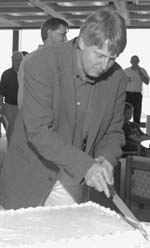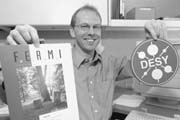 |
|
The DESY-Fermilab Connection by Kurt Riesselmann
July 3rd, 1983: Ferdinand Willeke, physicist from the German high-energy physics laboratory DESY (Deutsches Elektronen-Synchrotron), witnessed the Tevatron setting a new world energy record. "I happened to be on shift when acceleration up to 512 GeV was accomplished," says Willeke. "I was in the team of Frank Turkot and Hans Jöstlein, and I was declared `accelerator physics expert' of this team. It was great fun and very, very interesting. I still like to remember these days."
And so does Fermilab.
"Fermilab was quite a beneficiary of this collaboration," summarizes former Fermilab director John Peoples. "Siegfried Wolff and Hartwig Kaiser, physicists from DESY, contributed a lot to the development of the Tevatron magnets, the first use of superconducting magnets for building a high-energy accelerator."
The collaboration also benefited DESY. Wolff and Kaiser, returning to Hamburg, used their knowledge gained at Fermilab for the design of the superconducting magnets needed for the new HERA accelerator, Germanyís prime high-energy collider. As a result the "HERA magnet" with cold iron yoke was developed, providing an increase in magnetic field strength of about 20 percent compared to the original Tevatron design.
Helen Edwards, in 1992 a member of the machine advisory committee at DESY, became the first project manager for the TESLA test facility (TTF) in Hamburg. She and Don have spent many months at DESY Hamburg ever since.
"He did have a vision," Helen says of Wiik, who died in a tragic accident in 1999. "That's why I am interested in TTF."
Many Fermilab engineers contributed to the success of TTF. Mark Champion (couplers), Tom Peterson (cryogenic design) and Dan Wolff (modulators) are the people who were most closely involved in the collaboration. Champion and Peterson both worked more than a year in Hamburg. Peterson also is credited with the development of the vertical test stand used to check the quality of the superconducting cavities at TTF.
A highlight of the DESY-Fermilab collaboration on TTF was the construction of the RF gun, a device used to create a high-quality electron beam. It was designed and built by Fermilab engineers and scientists. In 1998 it was installed at the TTF facility of DESY Hamburg.
In 1994 Peoples, at that time director of Fermilab, also wanted the lab to become involved in photo-injector physics: "I wanted to have something here at Fermilab that was part of TTF, some work that was sort of pushing the envelope. I thought that accelerator technology was very valuable for Fermilab to know. Then Helen pro-posed the idea of the photoinjector."
The construction of the Fermilab photoinjector, in design similar to its TTF counterpart, was again a truly international collaboration, with DESY providing a nine-cell TESLA cavity and INFN Milan contributing a cathode preparation facility. Further input came from several U.S. universities, including the University of Rochester, and HEP institutes around the world.
Beam dynamics studies at Fermilab's photoinjector are relevant for a future low-emittance linear collider. The results are important both for the Next Linear Collider (NLC) and TeV-Energy Superconducting Linear Accelerator (TESLA) designs. They also show promise for application to high-energy electron cooling at the TeV energy scale. If successful, this technique could be used to maintain the quality of the beams at the Tevatron for long periods of time.
If physicists achieve the electron beam specifications of a linear collider without having to build a damping ring, "this would save about 100 million dollars, independent of the final accelerator technology [NLC or TESLA] that is eventually used," Brinkmann says. He would like to see the DESY-Fermilab co-operation intensified, especially since there are plenty of research topics, like beam focusing, that need investigation no matter what kind of machine will be built in the future.
Co-operation beyond accelerator technology
DESY alumnus Holtkamp receives Fermilab Employee Recognition Award
His wife and two sons originally were a little skeptical about leaving Hamburg. Things changed when he told his sons about living in a house with a garden big enough to keep a dog, something that did not seem possible when living in Hamburg. Eventually his family accepted, and a dog became the fifth member of the Holtkamp family soon after their arrival.
Holtkamp quickly managed to establish himself as an expert on accelerator technology for future machines. Together with David Finley he coordinated the technical study for a future neutrino factory, a machine that would use a muon storage ring to produce the most intense neutrino beam ever produced on earth. Their report, complemented by the report of Steve Geer and Heidi Schellman (Northwestern University) on the physics study, has received recognition by high-energy specialists around the world. Holtkamp, Finley and Geer were honored with a Fermilab Employee Recognition Award on May 8.
Fermilab physicist Richard Carrigan is using the photoinjector to create x-ray radiation that is potentially hundreds of times more powerful than that obtained from sources currently used at hospitals. Guiding the high-quality electron beam through a crystal, the intense x-ray radiation is produced by a mechanism called channeling radiation. Carrigan's collaborators at TH Darmstadt, Germany, have probed the possibility that hospitals could build x-ray facilities for heart studies and mammogram screening that could provide much better contrast, without having to rely on very large synchrotron light sources.
Fermilab director Mike Witherell confirms this point of view: "If there will be only enough funding for one TeV-scale collider, it is important that it will be built as a broadly based global project tied to laboratories around the world. No matter where a linear collider is built, it needs to be a part of the core program for laboratories elsewhere." He credits Wagner with taking a leading role in that effort.
At a time of reduced budgets for high-energy physics, a single laboratory cannot explore all aspects relevant to a future accelerator. Laboratories need to expand their collaboration efforts. Regarding Fermilab's role, Witherell sees these priorities: "Linear colliders are an issue of intense interest for the worldwide high-energy physics community. It will come to a decision point in the near future, and Fermilab needs to be involved in that decision."
Collaborations like those that have been so effective for DESY and Fermilab in the past will be essential for the future.
Connecting with DESY Zeuthen
Another connection between DESY Zeuthen and Fermilab was established on May 1. Kurt Riesselmann, formerly working as public relations officer at Zeuthen, joined Fermilab's Office of Public Affairs. He already had strong connections with the Midwest: He received his Ph.D. in physics from the University of Wisconsin-Madison, and his wife, Lisa, is from Milwaukee.
|
| last modified 5/26/2000 email Fermilab |
FRLsDFx9eyfrPXgV

 Albrecht Wagner, director of DESY, acknowledges that "the tremendous progress made in super-conducting radiofrequency (RF) acceleration in TESLA would not have been possible without the strong engagement of Fermilab."
Albrecht Wagner, director of DESY, acknowledges that "the tremendous progress made in super-conducting radiofrequency (RF) acceleration in TESLA would not have been possible without the strong engagement of Fermilab."
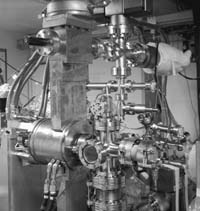 "The RF gun is a very sophisticated device," comments Reinhard Brinkmann, project manager of TTF. "We operate it day and night, seven days a week. It is extremely reliable, constantly proving Fermilab's competence."
"The RF gun is a very sophisticated device," comments Reinhard Brinkmann, project manager of TTF. "We operate it day and night, seven days a week. It is extremely reliable, constantly proving Fermilab's competence."
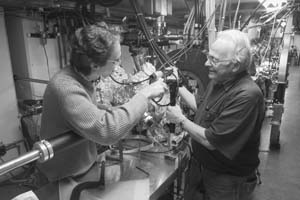 In early May, Reinhard Brinkmann and Klaus Flöttmann came to Fermilab to participate in measurements, triggered by the promising experimental results that the Fermilab photoinjector group had just obtained. Together with Yaroslav Derbenev, Brinkmann and Flöttmann discovered a new and completely surprising concept for improving the electron beam in an accelerator. They predicted that, without using expensive damping rings, it would be possible to convert a round electron beam to a flat beam with better quality. Experimenters at the Fermilab photoinjector were the first to observe the effect, a major breakthrough.
In early May, Reinhard Brinkmann and Klaus Flöttmann came to Fermilab to participate in measurements, triggered by the promising experimental results that the Fermilab photoinjector group had just obtained. Together with Yaroslav Derbenev, Brinkmann and Flöttmann discovered a new and completely surprising concept for improving the electron beam in an accelerator. They predicted that, without using expensive damping rings, it would be possible to convert a round electron beam to a flat beam with better quality. Experimenters at the Fermilab photoinjector were the first to observe the effect, a major breakthrough.
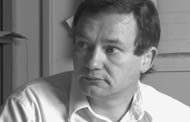 Kasemann has contributed to the DESY-Fermilab connection beyond his personal story. He has initiated an ongoing DESY-Fermilab co-operation on the development of mass storage. Both DESY and Fermilab use similar components, including commercial tape robots for data recording. To store data more efficiently, DESY extended its software to steer the tape robots. Fermilab, which faces unprecedented amounts of data when Tevatron Run II starts in 2001, joined DESY's efforts. In addition to the work done at Fermilab's Feynman Computing Center, Charles Waldmann, computing engineer in Fermilab's Computing Division, spent three months at DESY Hamburg to work on subsystems of tape recording software that will be used jointly at Fermilab and in the DESY system.
Kasemann has contributed to the DESY-Fermilab connection beyond his personal story. He has initiated an ongoing DESY-Fermilab co-operation on the development of mass storage. Both DESY and Fermilab use similar components, including commercial tape robots for data recording. To store data more efficiently, DESY extended its software to steer the tape robots. Fermilab, which faces unprecedented amounts of data when Tevatron Run II starts in 2001, joined DESY's efforts. In addition to the work done at Fermilab's Feynman Computing Center, Charles Waldmann, computing engineer in Fermilab's Computing Division, spent three months at DESY Hamburg to work on subsystems of tape recording software that will be used jointly at Fermilab and in the DESY system.
